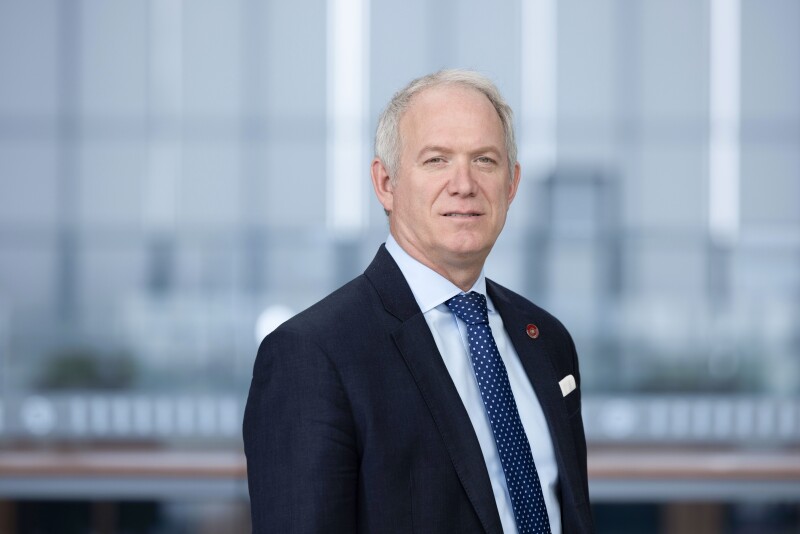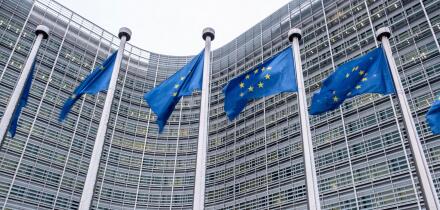The Asian Infrastructure Investment Bank, founded in 2015 at China’s initiative, has high ambitions, including making half its lending private sector. Its borrowing programme has grown rapidly to support that. Ahead of the AIIB’s annual general meeting next week in Samarkand, its chief financial officer Andrew Cross spoke to GlobalCapital about the institution’s plans and its perspective on the debates about reform reshaping the multilateral development bank sector.
GlobalCapital: As the youngest multilateral development bank, established less than a decade ago, and a relatively new bond issuer with a debut in 2019, where does the AIIB position itself amongst its MDB peers, and what are your key goals over the next few years?
Andrew Cross: We’ll celebrate our 10th anniversary next year, so AIIB has become the second largest MDB by membership in nine years. We’ve got 109 members — broadly speaking, the regional MDBs come in at around 50-60 members.

We’re well accepted within the MDB community, we participate in all the MDB forums and express the bank’s views and perspectives in all the audiences. On Capital Adequacy Framework reform, the bank is very involved, despite the fact that we have a colossal amount of capital. We can essentially double the balance sheet with our existing capital.
We’re very lean, with about 618 full time equivalent staff, which is very modest versus our peer group.
The AIIB is an active participant in COP, in terms of Paris alignment and how we think about climate financing, and in the G20 — though all MDBs are conscious that the G20 is a voice for 20 countries, but not all our members.
So we’re well established, with three triple-A credit ratings. But we’re well aware that we are guardians of a rare treasure — taxpayers’ money — and have an immense task ahead of us.
The AIIB has hit its goals in terms of climate financing, but we need to be very alert to how we can grow that.
We’re very focused on the agenda around private capital mobilisation. We established a target in 2020 that we wanted to do 50% of our lending to the private sector by 2030, which is a bit different from peers. At MDBs that do both public and private sector lending, that’s not typically the balance, and others do only one or the other. We see benefit in combining them.
The real prize has been recognition that the private sector is vital. We have $100bn of callable and paid-in capital, but the Asian infrastructure challenge is $3tr to $5tr, and if you think about climate change as well, we can’t solve any of this without the involvement of the private sector. So the big goal is: how to do more private capital mobilisation.
GlobalCapital: Where are you so far against that 50% private sector target?
Cross: Partly because of our Covid-19 response facility of $20bn, of which about $14bn was utilised, we did a lot of sovereign lending in those years, so we now have about an 80-20 split.
It’s a consequence of our shareholders articulating that as a counter-cyclical organisation, our role was to support sovereigns through those very difficult years. So we increased our sovereign lending, and those amounts tend to be larger.
But our members are still absolutely committed to the original 10 year strategy [including the 50% private sector goal].
In hiring staff, the policies of the bank, our approach to clients, we are very focused on being quick, nimble, lean and responsive. Sometimes the time it takes MDBs to do transactions can be quite long, and private sector timeframes are much shorter, so we’re trying to accommodate them, while maintaining the same standards.
We are one of the largest co-financers with the Asian Development Bank and IBRD, and can only do that if our standards are the same.
So we are a well established MDB, working in collaboration with our peers, trying to put the capital we have been given to work. For us it’s a bit different from the ‘better before bigger’ focus elsewhere in the sector, because we have learnt the lessons of all the other MDBs that came before. We could go back over 60 or 80 years and apply the lessons — for example, some of the CAF reforms are things we already do.
GlobalCapital: Could you expand on that, and also say what your stance is on the discussions you’re participating in about MDB reform, considering that as you say you don’t actually need more capital at the moment?
Cross: CAF reform is not a today agenda, it’s been around for almost two years. Each presidency that has taken on the G20 has been working to further it.
Gems [the MDBs’ collaboration to open up their joint Global Emerging Markets Risk Database of loan performance] is not the highest profile item [on the CAF reform agenda], but publishing credit data and credit metrics in the public domain so the private sector can with a greater level of detail make an appropriate risk assessment — that’s a public good, it’s absolutely vital.
AIIB is a big supporter of that work, which has mostly been done by the IFC, EBRD and others — after nine years we don’t have a lot of data to consider. But it’s an ongoing exercise and we want to put momentum behind it.
Conversely, in our capital structure we have 20% of our capital paid in, a much higher percentage than at most other MDBs.
So things that strengthen the capital base like hybrid capital, because we don’t have a capital constraint because we’ve had so much capital given to us, are not very relevant to AIIB.
However, in discussions with the three rating agencies on how they think about MDB capital, we’ve supported a lot of the impetus from the IADB and African Development Bank on [raising] statutory lending limits and enabling institutions to think about the governance of [callable capital] and opportunities for slightly increasing gearing.
GlobalCapital: You are issuing all your bonds as sustainable development bonds, and recently issued a digital bond. What other products or initiatives are you planning to introduce in your funding programme, for example outcome bonds?
Cross: AIIB does a consistent, standard funding programme in line with the MDB community. We are diversifying our investors, maturities, products — those are the things a well run MDB does. Darren [Stipe, head of funding] and Domenico [Nardelli, treasurer] are doing sensible things that make financial sense for AIIB. We’re coming in at about $10bn a year, which is linked to our liquidity book, and adding more currencies like euros and Aussie dollars.
On digital and outcome bonds, our approach may be a bit different. This is based on my experience of green bonds. My sense is that the first bond you do is important, but it is expensive to do — the legal fees are expensive. They can be in a finite way quite impactful. But sometimes the second and third bonds are more important, because the market is after scalability, momentum and impact.
So if you look at the digital note we did, it’s not the first, but the second and third ones, where we’ll be able to add size, with continual focus, to have something that is sustainable and makes sense [for investors].
And while I applaud all the work on new outcome bonds, I will applaud even more the second and third ones addressing the same issues. When we all got involved in green bonds, none of us knew what it was going to be, and now it’s a trillion dollar market. My hope is that these ideas are going to go the same path.
GlobalCapital: All the MDBs want to increase their private sector co-financing. How are you progressing on that and how do you plan to increase it?
Cross: We are not going to go down the originate to distribute model. What James Scriven is doing at IDB Invest [where he is CEO] makes an awful lot of sense, but at AIIB we are accumulating assets on the private sector side.
What we’ve started to think about is the securitization model — we’re trying to encourage loans to become bonds. For example, in Singapore with Bayfront and in Hong Kong with the Hong Kong Mortgage Corp we’ve established a warehouse and used the capital to buy loans from commercial banks. That brings more private sector investors in. The financial technology is very well tested and understood, and we use it to catalyse more investment from the private sector, release capital from banks and put [the assets] under the umbrella of an MDB. It’s really catalytic. These are really interesting structures because you can take them to different regulatory regimes.
GlobalCapital: But when you are financing infrastructure, there will typically be multiple lenders involved — do you have a target for how much should be lending by private investors?
Cross: At our heart we are a project finance institution, solely focused on infrastructure — though financial markets infrastructure is just as relevant as a solar park in India, for example. The board wants to be seeing 50% of our volume going to the private sector. That can be co-financing with other sponsors, equity, directly financing funds, a capital markets strategy using equity and debt. The shareholders are really clear that they want AIIB to be very active in working with the private sector.
The whole MDB community is trying to respond to shareholders saying ‘how do we work with the private sector?’ But infrastructure is a hard asset. Why do we do it? Because it’s impactful. Our assets will be around for 25 or 30 years. The shortest part of the process is origination. The loans stay on our books for a very long time, during which we do a lot of monitoring.
As much as we try and speed up [signing deals] we also have a responsibility, which is part of the magic of MDBs — our commitment to biodiversity, to indigenous peoples, to international procurement.
GlobalCapital: Even if how to leverage callable capital is not an issue for the AIIB now, since you are not capital-constrained, you have been participating in the debates. Do you think callable capital will end up being reformed in some way, to make it capable of being leveraged more, or do you think the fuss will die down and it will stay as it is?
Cross: I think the discussion is timely and really important. Callable capital has been a mainstay of MDB capital structures since 1944, and it’s absolutely appropriate for shareholders, MDBs and credit rating agencies to be taking a very close look at it and testing it against its effectiveness for what the owners would like the MDBs to achieve.
It’s difficult to know what the perfect solution is, though it looks like a really constructive debate. We’ve seen all the rating agencies engaging very thoughtfully in looking at their methodologies, reviewing them and debating in joint and open forums about criteria and subcriteria. There’s a lot of intellectual honesty about trying to examine it.
Secondly, shareholders are looking very clearly at it. Some countries have budgetary approval [already to disburse callable capital, should it ever be called] — what some call the ‘prudent component’. We’re gaining more clarity on how some countries have looked at it, so many countries are gaining much greater knowledge. And the MDBs are rightly also looking at ‘can we increase gearing on it?’
There’s a lot of intellectual horsepower trying to find a solution, because everyone recognises the MDBs as a system don’t have enough capital to meet the challenges.







